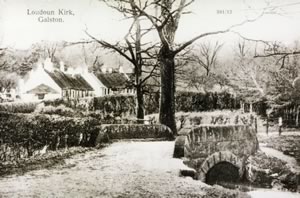

|
|
Lang Syne Publishers
120 Carstairs
St
Dalmarnock
Glasgow
Scotland
Ayrshire’s BrigadoonHugh Maxwell investigates the vanished village of Loudounkirk
This was the delightful village of Loudounkirk, hidden in a sheltered corner of the Irvine Valley near Galston. The tiny hamlet riginally took its name from the nearby church that dates back to 1451 when Lady Alicia Campbell, the tenant of the local castle, granted the land to the monks of Kilwinning Abbey in memory of her late husband Sir John. Loudounkirk became an idyllic spot with less than a hundred residents, most of them estate workers and their families living in a row of thatched cottages and paying an annual feu duty of three shillings and fourpence - plus two fat hens. The men were employed as gardeners, foresters, gamekeepers, stable hands and farm labourers in the extensive grounds of Loudoun Castle while the women worked as maids and servants. One visitor to the village in 1894 was so enamoured that he
wrote, “The birds which sing so sweetly here just about sunset had
now Beneath the rugged elms and the shade of the yew trees, as well as the ash and the weeping willow, the green turf is lying, while beautiful roses fill the summer air with their fragrance.” The condition of the cottages in many of these small villages was
dependent not only upon the pride of the tenants who lived
there In the early part of the 19th century, Lord Moira invested a huge amount of money on the Loudoun estate, including £100,000 on the castle itself. The latter now became one of the most attractive in the country and was proudly known as the Windsor of Scotland. During this period, the row of cottages, with their thatched roofs and clay flagstoned floors,were well maintained by the estate; and the tenants and their families also transformed the gardens into rich, colourful havens of flowers and shrubs. |
 It used to be one of the most
picturesque scenes imaginable - down in a small, secluded hollow
stood a row of thatched cottages against whose whitewashed walls
fragrantly scented woodbine and roses spread with wondrous
profusion; while, nearby, a sparkling burn disappeared under a
rustic stone bridge before gurgling past the walls of an old
kirkyard where the ruined chapel was surrounded by dark yew trees
gently swaying in the warm, sweetly scented, summer breeze.
It used to be one of the most
picturesque scenes imaginable - down in a small, secluded hollow
stood a row of thatched cottages against whose whitewashed walls
fragrantly scented woodbine and roses spread with wondrous
profusion; while, nearby, a sparkling burn disappeared under a
rustic stone bridge before gurgling past the walls of an old
kirkyard where the ruined chapel was surrounded by dark yew trees
gently swaying in the warm, sweetly scented, summer breeze.